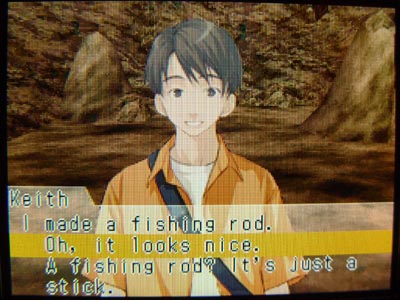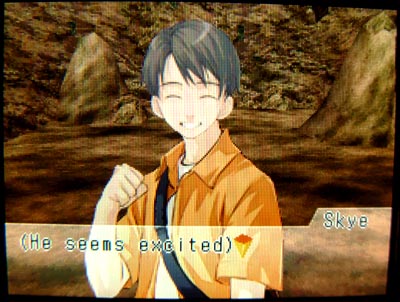The other day, I was nagging about how bad the usability of Lost in Blue is. This time, I would like to explain why I think the game is worth to take a closer look at, in spite of the usability issues.

How can somebody be not excited about a weapon?
Actually, a lot of positive things can be said about the game but there is one special twist, which had a profound effect on me as a player and I think it shows quite nicely the particular advantage of games over other media. This review contains many spoilers but I encourage you to read on.
There are only very few games which deal with survival on a deserted island. It is surprising since the setting is quite popular in movies and books. Considering this, the theme of Lost in Blue is well chosen. Also, the fact that there are two survivors: a boy and a girl, is well done too, since it opens up a whole social dimension. With just one character, you would deal only with the technical aspects of survial. If you look at the classics like “Robinson Crusoe”, “The Blue Lagoon” or “The Last Island” (and yes, “Lost” too – *sigh*) there are almost always other people on the island.
But what really makes Lost in Blue so great is the change of perspective. Let me explain. As you begin, the game is quite what you would expect. You control Keith, the boy who explores the island and collects food. Later, you build tools out of various sticks and stones and gain access to even more areas of the island and to more sources of food. It is your typical survival adventure fantasy.

F*ck yeah!
But also, you have to take care of Skye, the girl. Because she hurt her leg and can’t see without her glasses, she stays in the shelter all the time. She is responsible for the cooking so you have to talk to her if you want to eat something. Also, she is supposed to keep a bonfire burning and can generally help you in some cases. The problem is that she has to eat too and if she dies, the game is over. So you constantly have to interupt you survival adventure and make sure you make it back in time to feed her like some sort of virtual pet. Especially at the end of the game, managing Skye can get quite tough. If you want to stay away for a few days to travel far into the island, you have to stockpile food for her. Quite often, you come back and find out that she has neglected the bonfire and you have to fix it again. As you can read in various reviews, Skye is the source of a lot of frustration.
But as soon as play through the game once, the “Girl’s Story” mode is unlocked and suddenly, everything changes. Now you control Skye and Keith is your virtual pet. Every morning, he wakes up and runs of for some crazy adventure and you have to prepare him for that. While he is away you can access a very small part of the beach to collect some very basic food. Also, you find out that keeping the bonfire buring is a very difficult task as you can’t see how much time is left until the fire goes out. Sometime in the night, Keith returns and he completly failed to take care of himself. He will start talking about the puny, little adventures he had. You have to quickly take the little food he managed to collect and create a meal so he will make it through the night and the next day.

Very good Keith, but I won’t allow you play with it unless you eat your seaweed salad.
My point is that playing Skye, you will do exactly the mistakes you found so frustrating when you played Keith. You will accidently let the fire go out. You will intentionally starve almost to death because you have often no idea when Keith comes back and how long the food you have must last. Also, you notice some of the mistakes the AI-controlled Keith does and you realize that you did them yourself when you were playing Keith.
Further, you will also see Keith’s adventures from a fundamentally different point of view. What Keith does has very little relevance to what your day is about. You are more concerned with managing the food rations, cooking recipies and making sure you both are in good shape. Keith’s concerns seem so childish and trivial to you. Of course, at this point you already played as Keith and you know all the adventures so it even enhances that attitude.

Certainly he is just thinking about building another weapon.
And as if that is not enough, it gets even better. After you have completed the “Girl’s Story” you unlock “Challenge Mode” where you control the villain of the game. It seems that after Keith and Skye leave, the villain is punished by the police and is forced to stay at the island forever. So now you have to survive as long as possible with no hope for an escape and you are alone. It is an astonishing way to let you experience firsthand what the punishment of the villain feels like, rather then to spell it out or show it in a cutscene.

The Boss is quite enthusiastic about living alone on the island…
It struck me that Lost in Blue uses all the advantages of the medium. In other media, you are always forced to watch characters. The important thing about games is that you can get into a character and experience it firsthand. The idea that you can explore characters not by watching them but by actually replaying the story from their point of view is something I would like to see more often.
Please note that Lost in Blue is quite extraordinary here. In many games, you can change characters but most of the time, it has a negligible impact on the gameplay. It doesn’t matter if I select a Terrorist or a Counter-Terrorist, I still end up walking around and shooting people. In Lost in Blue, the controls for Keith and Skye are similar, but the game changes. Different things become important.
I also believe the game designers haven’t realized how powerful the change of perspective is. After all, the game portrays embarresing gender clichés. The girl in the kitchen, the boy hunting – it is the view on gender straight from the ancient times. At least they made the girl hurt her leg and loose her glasses as a superficial excuse.

The man stares idly at the bonfire while the woman prepares the food. It’s like the 1960s never happened.
Also the game designers failed to make the “Girl’s Story” as rich and interesting as the “Boy’s Story”. The activities that Skye has to do are limited and quite boring. Games like Cooking Mama already showed that just cooking can be a very exciting activity. In Lost in Blue it is just another generic minigame. Also, you get no help when trying to discover recipes. When you finally find a recipe, you don’t get a reward either. A testament for the weak gameplay is the “daydream” feature, which allows the player to fast forward time by pressing a button. Without it, players would be forced to simply do nothing and wait for long stretches of time. Of course, it is only avalible in the “Girl’s Story”.

No need to daydream yourself, just press Y. It’s true, games are killing the imagination of children.
It seems like the “Girl’s Story” and “Challege Mode” have been done in a rush and without much thought. I think if the designers knew about the importance of the change of perspective, they would make it a more elaborate point of the game. Still, Lost in Blue remains one of the kind. So the next time you are about to design characters in a game, consider allowing the player to switch to their perspective. You might even end up with the game equivalent to Scenes from a Marriage or Pulp Fiction.






[...] Lost in Blue: Change of Perspective [...]